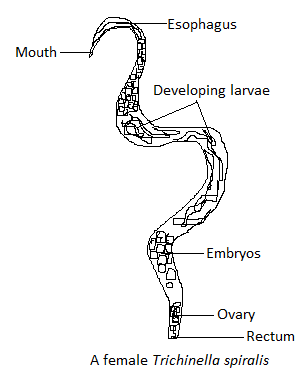
Which of the following endoparasites of humans does show viviparity?
A. Trichinella spiralis
B. Ascaris lumbiricoides
C. Ancyclostoma duodenale
D. Enterobius vermicularis
Answer
465.6k+ views
Hint:Parasitism refers to invasion by a harmful species which feeds on the nutrients of the host or affected organism. Endoparasites are types of parasites that live inside the host body. Viviparity means the development of the embryo inside the mother’s body. Endoparasite which shows viviparity is called pork worms.
Complete answer:Parasitism is a symbiotic relationship between one organism that gets benefited at the expanse of the other organism. The former is called a parasite and the latter is called the host. The host-parasitic association causes damage and injury to the host. Parasites can be classified as ectoparasites and endoparasites. The parasites which live outside the host are called ectoparasites and the parasites which live inside the host are called endoparasites.

Endoparasites can be further of two types. Those that live inside the cells of the host are called intercellular. On the other hand, those that live in the extracellular spaces of the host are called intracellular. Most of the nematodes, tapeworms, and helminths are intercellular.
Trichinella spiralis is a nematode species that are commonly found in rodents, horses, bears, pigs, and humans. They are also called pig worms as they cause disease trichinosis in humans through undercooked pork products. It is the smallest nematode parasite of humans. The females have developing eggs in their uterus located at the posterior portion of their slender body. The juveniles hatch from the anterior end of the female.
Hence, option A is correct.
Note: The average size of the Trichinella spiralis male is mm to mm. The females are twice in length as males. The worms appear to have a slender body at the anterior end more than the posterior end. Infection caused by this worm can be detected using a muscle biopsy. Mebendazole is the treatment for the worm.
Complete answer:Parasitism is a symbiotic relationship between one organism that gets benefited at the expanse of the other organism. The former is called a parasite and the latter is called the host. The host-parasitic association causes damage and injury to the host. Parasites can be classified as ectoparasites and endoparasites. The parasites which live outside the host are called ectoparasites and the parasites which live inside the host are called endoparasites.

Endoparasites can be further of two types. Those that live inside the cells of the host are called intercellular. On the other hand, those that live in the extracellular spaces of the host are called intracellular. Most of the nematodes, tapeworms, and helminths are intercellular.
Trichinella spiralis is a nematode species that are commonly found in rodents, horses, bears, pigs, and humans. They are also called pig worms as they cause disease trichinosis in humans through undercooked pork products. It is the smallest nematode parasite of humans. The females have developing eggs in their uterus located at the posterior portion of their slender body. The juveniles hatch from the anterior end of the female.
Hence, option A is correct.
Note: The average size of the Trichinella spiralis male is mm to mm. The females are twice in length as males. The worms appear to have a slender body at the anterior end more than the posterior end. Infection caused by this worm can be detected using a muscle biopsy. Mebendazole is the treatment for the worm.
Recently Updated Pages
The correct geometry and hybridization for XeF4 are class 11 chemistry CBSE

Water softening by Clarks process uses ACalcium bicarbonate class 11 chemistry CBSE

With reference to graphite and diamond which of the class 11 chemistry CBSE

A certain household has consumed 250 units of energy class 11 physics CBSE

The lightest metal known is A beryllium B lithium C class 11 chemistry CBSE

What is the formula mass of the iodine molecule class 11 chemistry CBSE

Trending doubts
State the laws of reflection of light

One Metric ton is equal to kg A 10000 B 1000 C 100 class 11 physics CBSE

Difference Between Prokaryotic Cells and Eukaryotic Cells

How do I convert ms to kmh Give an example class 11 physics CBSE

Describe the effects of the Second World War class 11 social science CBSE

Which of the following methods is suitable for preventing class 11 chemistry CBSE




